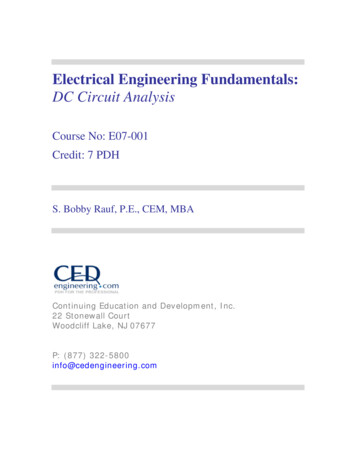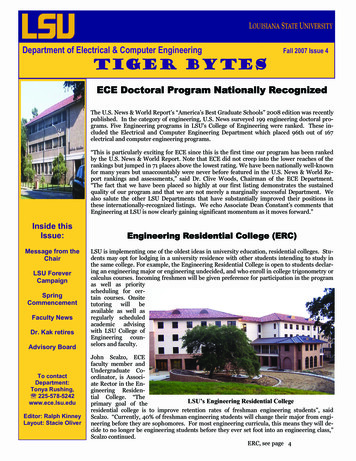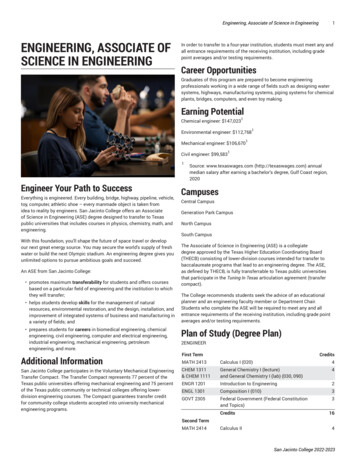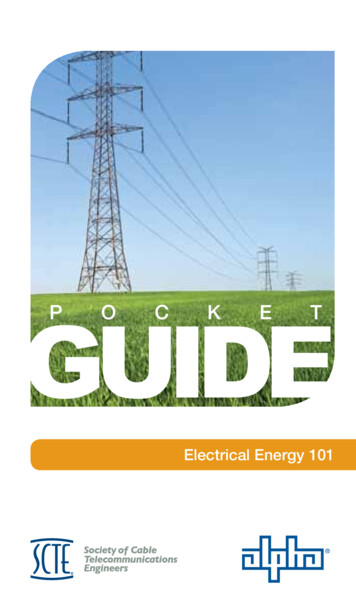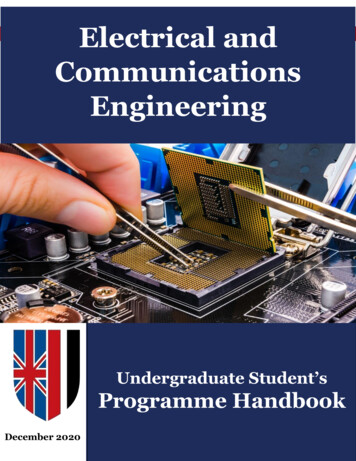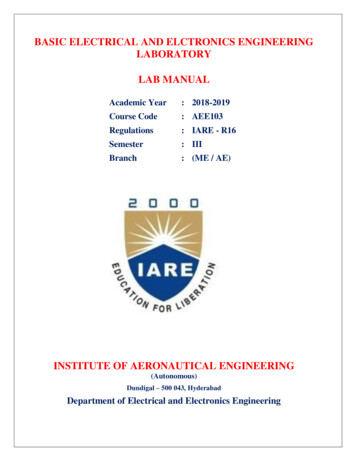
Transcription
BASIC ELECTRICAL AND ELCTRONICS ENGINEERINGLABORATORYLAB MANUALAcademic Year: 2018-2019Course Code: AEE103Regulations: IARE - R16Semester: IIIBranch: (ME / AE)INSTITUTE OF AERONAUTICAL ENGINEERING(Autonomous)Dundigal – 500 043, HyderabadDepartment of Electrical and Electronics Engineering
INSTITUTE OF AERONAUTICAL ENGINEERING(Autonomous)Dundigal, Hyderabad - 500 043AERONAUTICAL ENGINEERINGProgram OutcomesPO1Engineering knowledge: Apply the knowledge of mathematics, science, engineering fundamentals,and an engineering specialization to the solution of complex engineering problems.PO2Problem analysis: Identify, formulate, review research literature, and analyze complex engineeringproblems reaching substantiated conclusions using first principles of mathematics, natural sciences,and engineering sciencesPO3Design/development of solutions: Design solutions for complex engineering problems and designsystem components or processes that meet the specified needs with appropriate consideration for thepublic health and safety, and the cultural, societal, and environmental considerations.PO4Conduct investigations of complex problems: Use research-based knowledge and researchmethods including design of experiments, analysis and interpretation of data, and synthesis of theinformation to provide valid conclusions.PO5Modern tool usage: Create, select, and apply appropriate techniques, resources, and modernengineering and IT tools including prediction and modeling to complex engineering activities withan understanding of the limitations.PO6The engineer and society: Apply reasoning informed by the contextual knowledge to assesssocietal, health, safety, legal and cultural issues and the consequent responsibilities relevant to theprofessional engineering practice.PO7Environment and sustainability: Understand the impact of the professional engineering solutionsin societal and environmental contexts, and demonstrate the knowledge of, and need for sustainabledevelopment.PO8Ethics: Apply ethical principles and commit to professional ethics and responsibilities and norms ofthe engineering practice.PO9Individual and team work: Function effectively as an individual, and as a member or leader indiverse teams, and in multidisciplinary settings.PO10Communication: Communicate effectively on complex engineering activities with the engineeringcommunity and with society at large, such as, being able to comprehend and write effective reportsand design documentation, make effective presentations, and give and receive clear instructions.PO11Life-long learning: Recognize the need for, and have the preparation and ability to engage inindependent and life-long learning in the broadest context of technological change.PO12Project management and finance: Demonstrate knowledge and understanding of the engineeringand management principles and apply these to one’s own work, as a member and leader in a team, tomanage projects and in multidisciplinary environments.Program Specific OutcomesPage 2
PSO1Professional Skills: Able to utilize the knowledge of high voltage engineering in collaboration withpower systems in innovative, dynamic and challenging environment, for the research based teamwork.PSO2Problem - Solving Skills: To explore the scientific theories, ideas, methodologies and the newcutting edge technologies in renewable energy engineering, and use this erudition in theirprofessional development and gain sufficient competence to solve the current and future energyproblems universally.PSO3Successful Career and Entrepreneurship: To be able to utilize of technologies like PLC, PMC,process controllers, transducers and HMI and design, install, test, and maintain power systems andindustrial applications.Page 3
INDEXS. NoName of the ExperimentPage No1Verification of Kirchhoff’s current and voltage laws.2Verification of ohms law.10 - 123Magnetization characteristics of DC shunt generator.13 - 154Swinburne’s test on DC shunt machine.16 - 195Open circuit and short circuit test on single phase transformer.20 - 246Study the performance characteristics of three phase induction motor by braketest.25 - 287Determine the regulation of alternator using synchronous impedance method.29 - 338PN junction diode characteristics.34-379Zener diode characteristics.38-4210Half wave rectifier circuit.43-4711Full wave rectifier circuit.48-5212Transistor common emitter characteristics.53-5613Transistor common base characteristics.57-6114Study of CRO.7-9ATTAINMENT OF PROGRAM OUTCOMES & PROGRAM SPECIFIC OUTCOMESPage 4
Exp.NoExperimentProgramOutcomesAttainedProgram SpecificOutcomesAttained1Verification of Kirchhoff’s current and voltage laws.PO1,PO2PSO22Verification of ohms law.PO1,PO2PSO23Magnetization characteristics of DC shunt generator.PO1,PO2PSO24Predetermination of efficiency (Swinburne’s test) of DC shuntmachine.PO1,PO2, PO3PSO25Open circuit and short circuit test on single phase transformer.PO1,PO2,PO4PSO16Study the performance characteristics of three phase inductionmotor by brake test.PO1,PO2PSO27Determine the regulation of alternator using synchronousimpedance method.PO1,PO2PSO18PN junction diode characteristics.PO1,PO2PSO29Zener diode characteristics.PO1,PO2,PO4PSO110Half wave rectifier circuit.PO1,PO2,PO4PSO111Full wave rectifier circuit.PO1,PO2PSO212Transistor common emitter characteristics.PO1,PO2,PO4PSO213Transistor common base characteristics.PO1,PO2,PO4PSO214Study of CRO.Page 5
BASIC ELECTRICAL AND ELCTRONICS ENGINEERINGLABORATORYOBJECTIVE:The objective of Basic electrical and electronics engineering laboratory is to learn the practical experiencewith operation and applications electromechanical energy conversion devices such as DC machines,transformers, three phase induction motors and alternators. It also aims to get the knowledge of the differentelectronic devices like diodes, rectifiers, transistors and how these devices are used in real time applications.It also makes the students to learn how to measure the electrical quantities with different measuring devicesand with CRO.OUTCOMES:Upon the completion of electrical and electronics practical course, the student will be able to:1. Understand the operation and applications of electromechanical energy conversion devices.2. Understand identification and selection of various electrical and electronic components.3. Analyze the characteristics of various electronics components.Page 6
EXPERIMENT – 1VERIFICATION OF KIRCHHOFF’S CURRENT AND VOLTAGE LAWS1.1AIM:To verify Kirchhoff’s voltage law (KVL) and Kirchhoff’s current law (KCL) in a passive resistivenetwork1.2APPARATUS REQUIRED:S. No1.3Apparatus Name1RPS2Ammeter3Voltmeter4Resistors5Bread Board6Connecting WiresRangeTypeQuantityCIRCUIT DIAGRAMS:Circuit to verify KVL:Fig - 1 KVLTo Verify KCL:Fig - 1 KCLPage 7
1.4PROCEDURE:To Verify KVL1.2.3.4.5.Connect the circuit diagram as shown in Figure 1.Switch ON the supply to RPS.Apply the voltage (say 5v) and note the voltmeter readings.Sum up the voltmeter readings (voltage drops), that should be equal to applied voltage.Thus KVL is verified practically.To Verify KCL1.2.3.4.5.1.5Connect the circuit diagram as shown in Figure 2.Switch ON the supply to RPS.Apply the voltage (say 5v) and note the ammeter readings.Sum up the Ammeter readings (I 1 and I2), that should be equal to total current (I).Thus KCL is verified practically.OBSERVATIONS:For KVLAppliedVoltageV1 (volts)V(volts)Theoretical PracticalV2 (volts)V3 (volts)V1 V2 V3 (volts)Theoretical practical Theoretical practical Theoretical practicalFor KCLAppliedI (A)VoltageV (volts) Theoretical Practical1.6I1 (A)I2 (A)I1 I2 (A)Theoretical practical Theoretical practical Theoretical practicalPRECAUTIONS:1. Check for proper connections before switching ON the supply.2. Make sure of proper color coding of resistors.3. The terminal of the resistance should be properly connected.1.7RESULT:Page 8
1.8PRE LAB VIVA QUESTIONS:1.2.3.4.5.1.9What is current?What is voltage?What is resistance?What is ohm’s law?What is KCL and KVL?POST LAB VIVA QUESTIONS:1.2.3.4.5.6.What do you mean by junction?What directions should be assumed for KCL?What are the positive and negative signs in KVL?What is the colour coding of resistors?What are the precautions to be taken while doing the experiment?What is the range of ammeters and voltmeters you used in this experiment?Page 9
EXPERIMENT – 2VERIFICATION OF OHM’S LAW2.1AIM:To verify Ohm’s law for a given resistive network.2.2APPARATUS REQUIRED:S. No2.3Apparatus Name1RPS2Ammeter3Voltmeter4Resistor5Rheostat6Bread Board7Connecting WiresRangeTypeQuantityCIRCUIT DIAGRAM:Fig – 2.1 Circuit Diagram2.4PROCEDURE:1. Make the connections as per circuit diagram.2. Switch ON the power supply to RPS and apply a voltage (say 10V) and take the reading ofvoltmeter and ammeter.3. Adjust the rheostat in steps and take down the readings of ammeter and voltmeter.4. Plot a graph with V along x-axis and I along y-axis.5. The graph will be a straight line which verifies Ohm's law.6. Determine the slope of the V-I graph. The reciprocal of the slope gives resistance of the wire.Page 10
2.5OBSERVATIONS:S. No.2.6Voltage (V)Current (mA)MODEL GRAPH:Fig: 2.2 Voltage and Current Characteristics2.7PRECAUTIONS:1. Take care to connect the ammeter and voltmeter with their correct polarity.2. Make sure of proper color coding of resistors.3. The terminal of the resistance should be properly connected.2.8RESULT:Page 11
2.9PRE LAB QUESTIONS:1.2.3.4.5.6.2.10What is current?What is voltage?Define charge.Define power.What is the resistance?What is ohm’s law?POST LAB QUESTIONS:1.2.3.4.5.6.What do you mean by junction?What is the colour coding of resistors?What are the precautions to be taken while doing the experiment?What is the range of ammeters and voltmeters you used in this experiment?What are the limitations of ohm’s law?What is the condition of ohm’s law?Page 12
EXPERIMENT – 3MAGNETIZATION CHARACTERISTICS OF DC SHUNT GENERATOR3.1AIM:To determine experimentally the Magnetization (or) Open Circuit Characteristics of a D.C. ShuntGenerator and also to determine the critical field resistance.3.2APPARATUS REQUIRED:S. No.3.3Apparatus ing WiresRangeQuantityNAME PLATE DETAILS:MOTORGENERATORVoltage (V)Voltage (V)Current (A)Current (A)Output (KW/HP)Output (KW/HP)Speed (RPM)Speed (RPM)Excitation type3.4TypeShuntExcitation typeExcitation voltage (V)Excitation voltage (V)Excitation current (A)Excitation current (A)ShuntCIRCUIT DIAGRAM:Fig – 3.1Magnetization characteristics (or) open circuit characteristics of a DC shuntgeneratorPage 13
3.5PROCEDURE:1. Choose the proper ranges of meters after noting the name plate details of the given machine andmake the connections as per the circuit diagram.2. Keep the field rheostat of motor in minimum position and field rheostat of generator in maximumposition.3. Switch ON the power supply and start the M-G set by slowly moving the handle of three pointstarter.4. Observe the speed of the generator using a tachometer and adjust the speed to rated value byvarying the motor field rheostat. Keep the same speed throughout the experiment.5. Note down the terminal voltage of the generator at zero field current. This is the E.M.F. due toresidual magnetism.6. Increase the generator field current I f (ammeter) by gradually moving the jockey of generator fieldrheostat. For every value of I f, note down the corresponding voltmeter reading. Increase the fieldcurrent till induced E.M.F. is about 120% of rated value.7. Repeat the same procedure for decreasing values of the same field currents (I f) and finally notedown the E.M.F. generated due to residual magnetism.8. Draw the characteristics of generated E.M.F. (Eg) versus field current (If) for both increasing anddecreasing values of field current.9. Draw a tangent line to the initial portion of Characteristics from the origin. The slope of thisstraight line gives the critical field Field Current Generated Voltage Field Current Generated VoltageIf (amp)Eg (volts)If (amp)Eg (volts)Page 14
3.7MODEL GRAGH:Fig – 3.2 Open Circuit Characteristics of DC shunt generator3.8PRECAUTIONS:1. The experiment should be done at constant speed.2. The jockey should be moved only in one direction. It should not be moved back and forth forobtaining a particular field current.3. At zero field there would be some EMF due to residual magnetism4. Avoid parallax errors and loose connections3.9RESULT:3.10PRE LAB QUESTIONS:1.2.3.4.5.6.3.11What is a generator?What is the principle of operation of generator?What are the different types of generators?What is residual magnetism?What is the Flemings right hand rule?What is the EMF equation of generator?POST LAB QUESTIONS:1.2.3.4.5.What is the rating of generator used?What is the motor rating used?What is meant by starter?What type of starter is used in your experiment?How you can vary the speed of generator?Page 15
EXPERIMENT – 4SWINBURNE’S TEST ON DC SHUNT MACHINE4.1AIM:To pre-determine the efficiency of a DC shunt machine when run both as generator and motor.4.2APPARATUS REQUIRED:S. No.4.3Name of the meterRangeTypeQuantityNAME PLATE DETAILSMOTORVoltage (V)Current (A)Output (KW/HP)Speed (RPM)Excitation TypeShuntExcitation VoltageExcitation current4.4CIRCUIT DIAGRAM:20AFig – 4.1 Swinburne’s test on a D.C. Shunt MachinePage 16
4.5PROCEDURE:1. Choose the proper ranges of meters after noting the name plate details of the given machine andmake the connections as per the circuit diagram.2. Keep the motor field rheostat the minimum position, and start the motor by closing the switch andoperating the starter slowly.3. Run the motor at rated speed by adjusting the motor field rheostat.4. Note down the voltage, no load current and field current.4.6OBSERVATIONS:S. No.4.7VL (V)ILo (A)If (A)MODEL GRAPH:Fig - 4.2 Performance characteristics of DC shunt machine4.8CALCULATIONS FOR SWINBURNE’S TEST:From the no load test results,Supply voltage VL Volts.No load line current ILoAmperes.Field current If Amperes.Therefore No load Armature Current Iao IL-If Amperes.No load copper losses are Iao2 RaWhere Ra is the armature resistanceNo load power input VLILConstant losses (No load power input - No load copper losses). ------------ (1)Efficiency as motor:Efficiency output/input (input – total losses)/ input.Where total losses constant losses variable losses.Constant losses are known value from the equation (1)Variable loss Ia2 Ra , where Ia IL-IfPage 17
Input VLIL, VL is rated voltage of the machineAssume line currents (IL) as 2A, 4A,6A,----and find corresponding efficiencyEfficiency as generator:Efficiency output/input output / (output total losses).Where losses constant losses variable lossesConstant losses are same for both motor and GeneratorArmature Current Ia IL IfVariable loss Ia2 RaOutput power VLIL .VL is rated voltage of the machineAssume load currents (IL) as 2A, 4A,6A,---- and find corresponding efficiencies4.9OBSERVATIONS:As a Motor:S.No.ILRated voltage VL InputPowerPi VLILAs a Generator:Rated voltage VL S.No.ILOutputPowerPo VLILConstantlossesW const.Rated speed N CopperlossesWcu Ia2RaTotal losses (Wcons. Wcu)Outputpower (Pi – Totallosses) Total losses (Wcons. Wcu)Input power (Po Totallosses) Rated speed N ConstantlossesW const.CopperlossesWcu Ia2RaPage 18
4.10PRECAUTIONS:1. Run the motor at rated speed and rated voltage.2. Avoid loose connections and parallax errors.4.11RESULTS:4.12PRE LAB QUESTIONS:1.2.3.4.5.4.13What is the principle of alternator?What is meant by regulation?What is meant by synchronous impedance?What is meant by mmf?How the alternators be rated?POST LAB QUESTIONS:1.2.3.4.5.How you determine the synchronous impedance in this method?How the input to an alternator be given in your experiment?Why DC supply only given to Field winding of an alternator?How the frequency of an alternator is changes?What is the effect of excitation on Current and Power factor?Page 19
EXPERIMENT – 5OPEN CIRCUIT AND SHORT CIRCUIT TESTS ON SINGLE PHASE TRANSFORMER5.1AIM:To perform open circuit and short circuit tests on a single phase transformer and to pre-determine theefficiency, regulation and equivalent circuit of the transformer.5.25.3APPARATUS REQUIRED:S. No.Apparatus 4Wattmeter5Connecting WiresRangeQuantityNAME PLATE DETAILS:Transformer Specifications5.4TypeAutotransformer SpecificationsCapacity (KVA)Capacity (KVA)Primary Voltage (V)Input Voltage (V)Secondary Voltage (V)Output Voltage (V)PhasePhaseFrequency (Hz)Frequency (Hz)CIRCUIT DIAGRAMS:Fig -5.1 Open Circuit TestPage 20
Fig - 5.2 Short Circuit Test5.5PROCEDURE:Open Circuit Test:1.2.3.4.5.6.Connections are made as per the circuit diagram.Ensure that variac is set to zero output voltage position before starting the experiment.Switch ON the supply. Now apply the rated voltage to the Primary winding by using Variac.The readings of the Voltmeter, ammeter and wattmeter are noted down in Tabular form.Then Variac is set to zero output position and switch OFF the supply.Calculate Ro and Xo from the readings.Short Circuit Test:1.2.3.4.5.6.5.6Connections are made as per the circuit diagram.Ensure that variac is set to zero output voltage position before starting the experiment.Switch ON the supply. Now apply the rated Current to the Primary winding by using variac.The readings of the Voltmeter, ammeter and wattmeter are noted down in Tabular form.Then Variac is set to zero output position and switch OFF the supply.Calculate Ro1 and Xo1 from the readings.OBSERVATIONS:Open Circuit TestVoltage( Vo)Current(Io)Short Circuit TestPower(Wo)Voltage( VSC)Current(ISC)Power(WSC)Page 21
5.7EQUIVALENT CIRCUIT OF TRANSFORMER:Fig – 5.3 Equivalent circuit of single phase transformer5.8MODEL CALCULATIONS:Find the equivalent circuit parameters R0, X0, R1e, R2e, X1e and X2e from the O. C. and S. C. test resultsand draw the equivalent circuit referred to primary side.Let the transformer be the step-up transformer (115/230V), thenPrimary is H. V. side.Secondary is L. V. sideFrom OC test:Wocos o V o IoWorking component of current Ic Io * cos 0Magnetizing component of current Im Io * sin 0R0 X0 V0Where Ic I0cos 0IcV0Where Im I0 sin 0ImFrom SC Test:WSC2ISCR 2e Z2e X2e V SCI SC 2R22e X2e2Z2e R22eThus we will get the equivalent circuit parameters referred to primary side of the transformer. Thesecondary side parameters also calculated by using the transformation ratio K.R1e R1e /K 2X1e X1e /K 2Where K V2 Transformation ratio.V1Calculations to find efficiency and regulation from OC and SC testsThe efficiency and Regulation can be Predetermined at any load (n) and any power factor using theformulas given below% ɳ at any load n (VA ) cos n (VA ) cos W o n 2 W scPage 22
Where n Fraction of full loadn 1 (at full load)n ½ (at half load)n ¼ (at quarter load)% Re gulation(% R ) I 1 R 1 e cos I 1 X 1 e sin x 100V1Where V1 is the rated Voltage andI1 is the rated current for full load, and for any load I1 n*Irated‘ ’ for lagging power factors‘-‘ for leading power factorCos 1.0LoadnPcu (W) n2* WscPi (W) WoO/P (W) n* (VA)*Cos I/P (W) O/P Pcu Pi (%)O/P (W) n* (VA)*Cos I/P (W) O/P Pcu Pi (%)%RLagLeadCos 0.8Loadn5.9Pcu (W) n2* WscPi (W) Wo%RLagLeadMODEL GRAPH:Fig – 5.4 Load vs Efficiency characteristicsPage 23
5.10PRECAUTIONS:1. Connections must be made tight2. Before making or breaking the circuit, supply must be switched off5.11RESULT:5.12PRE LAB QUESTIONS:1.2.3.4.5.5.13What is a transformer?What is the principle of transformer?What happens when a DC supply is given to a transformer?What are the types of transformer?What is transformation ratio?POST LAB QUESTIONS:1.2.3.4.5.How the transformer is rated?Why OC and SC tests are conducted on transformers?On which side of the transformer OC test is conducted? Why?On which side of the transformer SC test is conducted? Why?What is the condition for maximum efficiency of transformer?Page 24
EXPERIMENT – 6BRAKE TEST ON 3- ɸ SQUIRREL CAGE INDUCTION MOTOR6.1AIM:To determine the efficiency of 3- ɸ induction motor by performing load test and to obtain theperformance curves for the same.6.26.3APPARATUS REQUIRED:S. r5Connecting WiresRangeTypeNAME PLATE DETAILS:3- ɸ Squirrel Cage Induction Motor6.4Quantity3- ɸ Auto TransformerVoltage (V)Capacity (KVA)Current (A)Input Voltage (V)Power (KW/HP)Output Voltage (V)Speed (RPM)PhaseFrequency (Hz)Frequency (Hz)CIRCUIT DIAGRAM:Fig – 6.1 Brake test on three – phase squirrel cage induction motorPage 25
6.5PROCEDURE:1. Connections are made as per the circuit diagram.2. Ensure that the 3- ɸ variac is kept at minimum output voltage position and belt is freely suspended.3. Switch ON the supply, Increase the variac output voltage gradually until rated voltage is observedin voltmeter. Note that the induction motor takes large current initially, so keep an eye on theammeter such that the starting current should exceed the rated current.4. By the time speed gains rated value, note down the readings of voltmeter, ammeter, and wattmeterat no-load.5. Now the increase the mechanical load by tightening the belt around the brake drum gradually insteps.6. Note down the various meters readings at different values of load till the ammeter shows the ratedcurrent.7. Reduce the load on the motor and also bring the variac to minimum position, then switch OFF thesupply.6.6MODEL CALCULATIONS:Input power drawn by the motor W (W1 W2) wattsShaft Torque, T sh 9.81* R* (S1 S2) N-mWhere R is the Radius of drum in meters.2 N T shOutput power Po watts60% EfficiencyOutputInput% slip Ns NNx 100sPowerPowerin wattsx 100in watts where Power factor of the induction motorNcos s 120 x f p Pi3 V IPage 26
6.7OBSERVATIONS:PowerW (Watts) SpeedS. VINNo. (V) (A)(RPM)W1 W26.8Spring balance(Kg)S1S2S1 S2TorqueT(N-m)InputPowerPi W1 W2(Watts)OutputPower𝟐𝛑𝐍𝐓Po 𝟔𝟎(Watts)%ηMODEL GRAPHS:Fig – 6.2 Performance characteristics of three phase induction motor6.9PRECAUTIONS:1. Connections must be made tight.2. Parallax errors must be avoided while taking the readings.3. Pour the water in the brake drum for cooling purpose.Page 27
6.10RESULT:6.11PRE LAB QUESTIONS:1.2.3.4.5.6.12What is the principle of operation of induction motor?What is meant by slip of induction motor?What are the types of 3-phase induction motors?What is Lenz’s law?What is the difference between slip ring and squirrel cage induction motors?POST LAB QUESTIONS:1.2.3.4.5.How induction motor speed can be reversed?What you do if the wattmeter shows the reading in reverse direction?What is the slip at standstill?How long the load on the motor be increased?What is the rating of induction motor you used?Page 28
EXPERIMENT – 7REGULATION OF AN ALTERNATOR USING SYNCHRONOUS IMPEDANCE METHOD7.1AIM:To find the regulation of a three-phase alternator by using synchronous impedance method.7.2APPARATUS REQUIRED:S. 5Tachometer6Connecting WiresTypeQuantityNAME PLATE DETAILS:3- ɸ AlternatorDC MotorVoltage (V)KVA ratingCurrent (A)Voltage (V)Output (KW/HP)Current (A)Speed (RPM)SpeedExcitation Type7.4RangeShuntPower factorExcitation VoltageExcitation VoltageExcitation currentRated CurrentCIRCUIT DIAGRAM:Page 29
7.5Fig – 7.1 Regulation of Alternator Using Synchronous Impedance MethodPROCEDURE:Open Circuit Test:1. Make the connections as per the circuit diagram.2. Before starting the experiment, the potential divider network in the alternator field circuit and field regulatorrheostat of motor circuit is set minimum resistance position.3. Switch ON the supply and close the DPST switch. The DC motor is started by moving starter handle.4. Adjust the field rheostat of DC motor to attain rated speed (equal to synchronous speed of alternator)5. By decreasing the field resistance of Alternator, the excitation current of alternator is increased gradually insteps.6. Note the readings of field current, and its corresponding armature voltage in a tabular column.7. The voltage readings are taken upto and 10% beyond the rated voltage of the machine.Short Circuit Test:1. For Short circuit test, before starting the experiment the potential divider is brought back to zero outputposition, i.e., resistance should be zero in value.2. Now close the TPST switch.3. The excitation of alternator is gradually increased in steps until rated current flows in the machine and notedown the readings of excitation current and load current (short circuit current)4. Switch OFF the supply.7.6OBSERVATIONS:OC testS.No.Field currentIf ( Amp.)OC voltageper phase Vo (volts)S.C. testS. No.Field currentIf ( Amp.)SC currentIsc Amp.Page 30
.7.7PROCEDURE TO FIND ARMATURE RESISTANCE OF ALTERNATOR:1. Connections are made as per the circuit diagram.2. Switch ON the supply. By varying the rheostat, take different readings of ammeter and voltmeter in a tabularcolumn.3. From the above readings, average resistance Ra of a armature is found out.7.7.1 CONNECTION DIAGRAM TO FIND Ra:Fig - 7.2 Circuit diagram for calculation of Resistance of armature winding of alternator7.7.2OBSERVATIONS:S. No.ArmaturecurrentI(amp)Armature voltageVa (volts)Rdc V / IPage 31
7.8PROCEDURE:1. Plot open circuit voltage, short circuit current verses field current on a graph sheet.2. From the graph, the synchronous impedance for the rated value of excitation is calculated.3. The excitation emf is calculated at full load current which is equal to the terminal voltage at No load.4. The voltage regulation is calculated at rated terminal voltage.7.9MODEL CALCULATIONS:Z SXV OCfor the same If and speedI SCS Z2S Ra2[ Ra RdC]Generated emf of alternator on no load isE0 v cos 2 v sin For lagging p. f.- For leading p. f. Ia Ra Ia XS 2The percentage regulation of alternator for a given p. f. is% Re g E0 Vx 100VWhereE0– Generated emf of alternator (or excitation voltage per phase)V – Full load, rated terminal voltage per phase.7.10MODEL GRAPHS:Draw the graph between If VS E0 per phase and If VS ISCPage 32
Fig – 7.3 OCC and SC characteristics of Alternator7.11PRECAUTIONS:1. Connections must be made tight2. Before making or breaking the circuit, supply must be switched off7.12RESULT:7.13PRE LAB QUESTIONS:1.2.3.4.5.7.14What is the principle of alternator?What is meant by regulation?What is meant by synchronous impedance?What is meant by mmf?How the alternators be rated?POST LAB QUESTIONS:1.2.3.4.5.How you determine the synchronous impedance in this method?How the input to an alternator be given in your experiment?Why DC supply only given to Field winding of an alternator?How the frequency of an alternator is changes?What is the effect of excitation on Current and Power factor?Page 33
EXPERIMENT – 8VOLT AMPERE CHARACTERISTICS OF P-N JUNCTION DIODE8.1AIM:To plot the V-I characteristics of a P-N junction diode in both forward and reverse directions, determine Cutin voltage (knee voltage), static and dynamic resistance in forward direction at forward current of 2mA &8mA respectively and find static and dynamic resistance at 10V in reverse bias condition.Page 34
8.2 APPARATUS:S.NoDevice1.Semiconductor diode trainerBoardContainingDC Power Supply.Diode (Silicon)Diode (Germanium)Carbon Film ResistorDC VoltmeterDC VoltmeterDC AmmeterDC AmmeterConnecting wires2.3.4.Range/RatingQuantity (in No.s)(0-15) V1N 4007OA791 KΩ, 1/2 W1111(0-1) V(0-20) V(0-200) μA(0-20) mA5A1111108.3 CIRCUIT DIAGRAMS:8.3.1 Forward BiasFigure – 8.3.1. Forward Bias Circuit8.3.2 Reverse BiasFigure – 8.3.2. Reverse Bias Circuit8.4 EXPECTED GRAPHS:Page 35
Figure – 8.4.1. Volt Ampere Characteristics of P-N Junction Diode8.5 TABULAR COLUMN:FORWARD BIASEs (volts)0.10.20.30.40.50.60.70.80.912468101214Ef (volts)If (mA)REVERSE BIASEs (volts)0.10.20.30.40.50.60.70.80.912468101214Er (volts)Ir (μA)Page 36
8.6 PRECAUTIONS:1. Ensure that the polarities of the power supply and the meters as per the circuit diagram.2. Keep the input voltage knob of the regulated power supply in minimum positionboth when switching ON or switching OFF the power supply.3. No loose contacts at the junctions.4. Ensure that the ratings of the meters are as per the circuit design for precision.8.7 CALCULATIONS:Forward BiasStatic Resistance at 8mA Ef / If Static resistance at 2mA Ef / If Dynamic resistance at 8mA Δ Ef / Δ If Dynamic resistance at 8mA Δ Ef / Δ If Reverse BiasStatic Resistance at (10V) Er / Ir Dynamic resistance at (10V) Δ Er / Δ Ir 8.8 RESULT:8.9 PRE LAB QUESTIONS:1.2.3.4.5.Define depletion region of a diode.What is meant by transition and space charge capacitance of a diode?Is the V-I relationship of a diode Linear or Exponential?Draw the ideal characteristics of P-N junction diode.What is the diode equation?8.10 POST LAB QUESTIONS:1.2.3.4.5.Define cut-in voltage of a diode and specify the values for Si and Ge diodes.What are the applications of a p-n diode?What is PIV?Define break down voltage.What is the effect of temperature on PN junction diodes?Page 37
EXPERIMENT NO: 9ZENER DIODE CHARACTERISTICS AND VOLTAGE REGULATOR9.1 AIM:Plot the V-I characteristics of a Zener diode, find Zener breakdown voltage in reverse bias condition, findstatic and dynamic resistance in both forward and reverse bias conditions and perform Zener diode voltageregulator.9.2 APPARATUS:S.NO1.2.3.4.DEVICESZener diode trainer BoardContaininga) DC Power Supply.b) Zener Diodec) Zener Dioded) Carbon Film ResistorDC VoltmeterDC Voltmetera) DC Ammeterb) DC AmmeterConnecting wiresRANGE/RATINGQUANTITY(in No.s)(0-15) V4.7 V6.2 V1 KΩ, 1/2
Engineering knowledge: Apply the knowledge of mathematics, science, engineering fundamentals, and an engineering specialization to the solution of complex engineering problems. PO2 Problem analysis: Identify, formulate, review research literature, and analyze complex engineering problems reaching substantiated conclusions using first principles .

